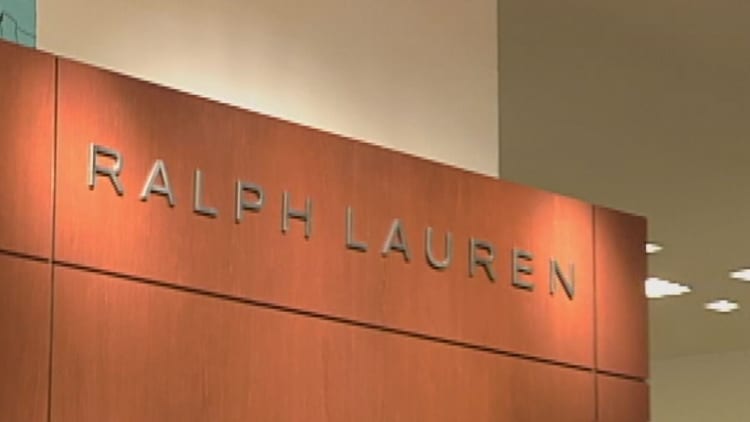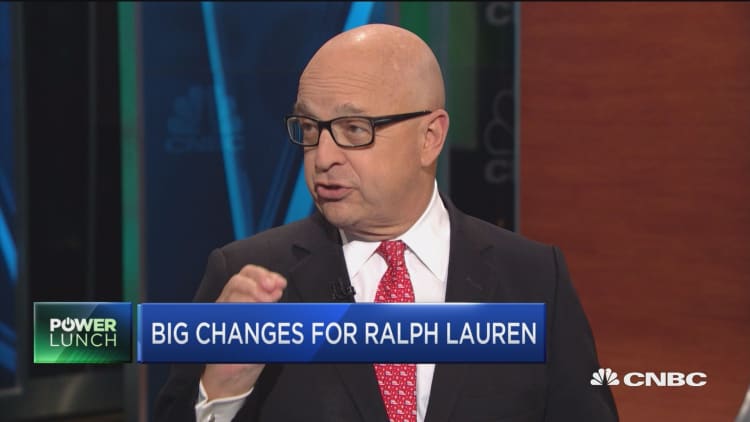
Stefan Larsson is bringing his Old Navy playbook over to Ralph Lauren, as the CEO seeks to speed up the amount of time it takes the brand's fashions to hit the shelves.
Meanwhile, the company said it will trim about 8 percent of its full-time head count and close more than 50 stores, in restructuring moves that are expected to save the brand up to $220 million annually. But not before some short-term pain.
In the fiscal first quarter, the company expects revenue to decline at a mid-single-digit rate. For the full year, it expects sales to decrease at a low-double-digit rate as it reduces its inventory levels, closes stores and faces continued weak traffic at its locations. That guidance excludes the restructuring and inventory charges associated with its latest restructuring activities.
Shares of Ralph Lauren were down roughly 3 percent Tuesday afternoon.
"They're doing all the right things," Jan Kniffen, CEO of J. Rogers Kniffen Worldwide Enterprises, told CNBC. "The question will be can they get it executed."
Larsson, who was named CEO of Ralph Lauren in September, lifted the lid on his plan to reignite sales growth at the specialty apparel brand on Tuesday, at the company's first-ever analyst day. Several of the initiatives paralleled the tactics he used to catapult Gap's Old Navy brand under his leadership.
They include cutting back on the time it takes a product to go from design to store shelves and improving the company's sourcing capabilities.
Larsson outlined how the company now uses 15-month lead times, meaning that it takes more than a year for its designs to be created and put in stores. As a result, it's planning and buying a season's assortment before the prior year's merchandise goes on sale, causing it to improperly forecast supply and demand.
Over the past three years, Ralph Lauren's sales have risen 7 percent, compared to an inventory build of 26 percent. That imbalance has led to more promotions and a skewed focus on outlet and other discount channels.
The company will now cut its lead times to nine months, which will enable it to better forecast demand, Larsson said. It will also strengthen its vendor relationships to make this lead time a moving target, and allow it to order certain merchandise closer to its selling date. Through these strategies, the goal is to sell more with less inventory on hand, the CEO said.
"We see a really clear plan to tap into the [company's] business potential," he said.
In addition to these changes, Larsson said the company would funnel more of its resources toward its three biggest labels, Ralph Lauren, Polo and Lauren. Its iconic styles (think blazers), which make up some 30 percent of its styles, drive 70 percent of its business. The company has already trimmed the number of its styles by 33 percent, which management said should boost its margins.
Larsson said Ralph Lauren will also tweak its distribution and expansion strategies and trim costs. The company will close more than 50 stores, or about 10 percent of its store base, that Larsson said do not strengthen the brand or drive profitable sales. Those closings follow 43 in the recently ended fiscal year. And though the CEO said he remains committed to the wholesale channel, Ralph Lauren will ship fewer products to those partners.

The company will provide additional details on changes to its distribution model after it runs a deeper analysis, Larsson said. But for the fiscal year, Ralph Lauren expects wholesale revenues to decline in the low-double-digit range, with sales at its retail stores expected to drop in the mid- to high-single digits. Wholesale accounts for roughly 46 percent of Ralph Lauren's revenues.
The company further plans to become a more "nimble" organization by moving from an average of nine to six management layers, resulting in a reduction of roughly 8 percent of its full-time head count, or more than 1,000 jobs. Combined, its restructuring activities are expected to save about $180 million to $220 million annually.
Those savings are in addition to the $125 million of annual cost savings the company previously announced, when it said it would cut about 5 percent of its full-time employees. Going forward, the company will continue to trim selling, general and administrative costs as a percentage of sales.
Ralph Lauren expects the latest restructuring moves to result in charges of as much as $400 million. It also anticipates an inventory charge of up to $150 million. These charges are expected to be mostly realized by the end of the current fiscal year.
As for sales, the company will work toward stabilizing trends during the current and upcoming fiscal years (fiscal 2017 and 2018). It anticipates a return to growth in fiscal year 2019, and a recapture of market share in fiscal 2020.
"I really think they've got the right team, the right plan and it's just a matter of time before this turns," Liz Dunn, founder & CEO of Talmage Advisors, told CNBC.
The company's net sales shrank 3 percent to $7.4 billion in the recently ended fiscal year. Its shares have fallen 30 percent over the past year.


